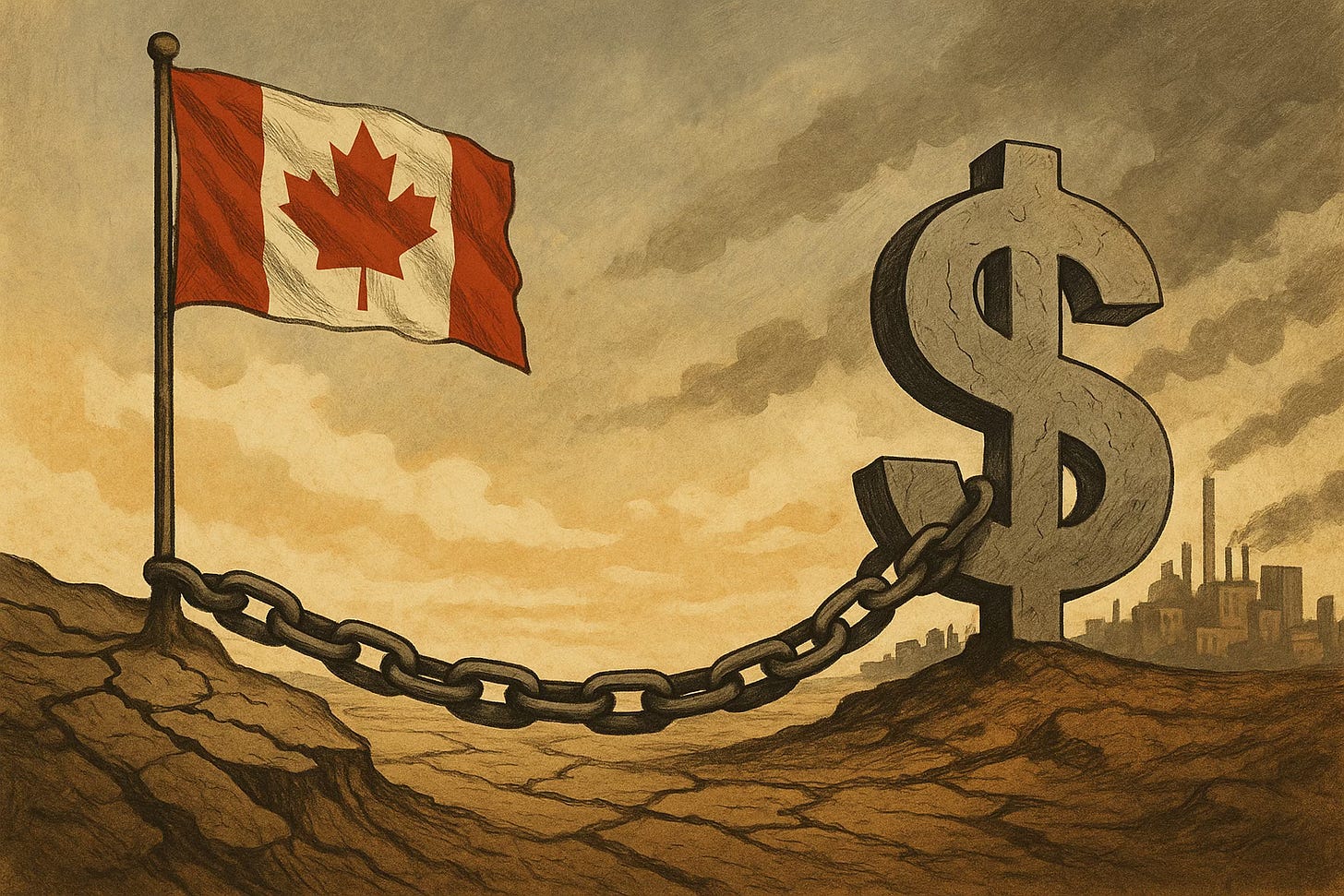Polite Canadian Stagnation
Tariffs, debt, and slow reforms weigh on Canada’s growth outlook.
They kept calling it resilient, polite, stable.
Canada’s macro narrative used to be maple-sweet. Real GDP growth for 2025, however, is fixed at 1 percent, last in the G7, and unemployment is drifting past 7 percent. Ottawa still murmurs about a “small tune-up,” yet every gauge flashes red.
Roughly two thirds of Canadian output leans on the United States. Convenient last century, risky today. Washington’s tariffs (25 percent on finished goods, 10 percent on energy and potash) turn the old handshake into an invoice. The Canada tariff impact is immediate. Ontario plants sit on excess inventory. Alberta crude sells at an ever-deeper discount. Atlantic fish processors chase European buyers only to see transport costs erase profits. Corporate boards shelve projects, hoard cash, and decide that waiting often pays better than producing.
This is what a colonial economy looks like once the empire looks inward.
Harsh. Also the most accurate line in Canadian macro commentary all year.
The Bank of Canada tries to soothe nerves with a 2.75 percent overnight rate. Tariff-fed inflation, however, stays above target until at least 2026. Deeper cuts would ignite a housing market already detached from wages, so monetary policy hovers while prices walk away.
Fiscal policy dives in with cheques: housing grants, childcare aid, green-tech subsidies. The bill, a deficit equal to 2.1 percent of GDP, eats into a debt cushion once viewed as sacrosanct. Bond desks notice, and the swap curve now whispers downgrade.
Productivity is the missing guest. Business R & D sits at 1.8 percent of GDP. Interprovincial barriers linger. Labour mobility erodes because households cling to ultra-low pandemic mortgages. This Canadian productivity crisis is now a design feature, not a passing glitch. The OECD expects per-capita output to expand below 1 percent a year through 2060.
Housing no longer hides the weakness. Equity lines are tapped, prices outrun incomes, and owners feel locked in. Talented engineers and data scientists look to Singapore or Austin instead of Saskatoon. The vaunted “brain gain” has aged into a slogan from another era.
Permitting reform might help, yet every riding guards its skyline. Councils delay approvals, provinces swap legal jabs, and federal incentives arrive without enforcement. NIMBY culture is now a macro drag.
Regulatory inertia does not stop at housing. Energy was supposed to be the trump card, but four million barrels a day still flow south. The Trans Mountain expansion bumps Vancouver prices for a season, then fades. LNG projects linger in presentation decks. Meanwhile Ottawa tightens emissions rules even as it banks on royalties.
Trade diversification lives mostly in speeches. Containers queue at U. S. customs while ministers toast Indo-Pacific partnerships. Sovereignty slogans ring hollow when your top buyer sets the price.
Canada still holds enviable cards: vast resources, a highly educated workforce, deep pension funds. Assets are necessary, not sufficient. They need policy oxygen. Internal barriers must fall so a nurse can move from Halifax to Calgary without repeating exams, and a grain truck can cross provincial lines without paperwork thicker than the cargo manifest. Housing must become infrastructure; tie federal transit money to hard density targets and dock transfers when permits sit idle beyond six months. R & D incentives should focus on tradable sectors such as biotech, aerospace, and advanced materials, and university incubators should answer to commercialisation boards rather than citation counts. Pension giants can safely steer a slice of their capital into domestic growth equity; even five percent would jolt the innovation circuit. New corridors must reach beyond the forty-ninth parallel, shipping grain to Chile, LNG to India, and rare earths to Europe.
Sceptics say the cure sounds extreme. Reality answers that the disease crossed that line long ago. One-percent growth paired with seven-percent joblessness chips away at real incomes and corrodes social trust. Delay only fattens the bill.
Polite stagnation is still stagnation.
Comfort will disappear on its own timetable. The choice is acceleration or irrelevance.


